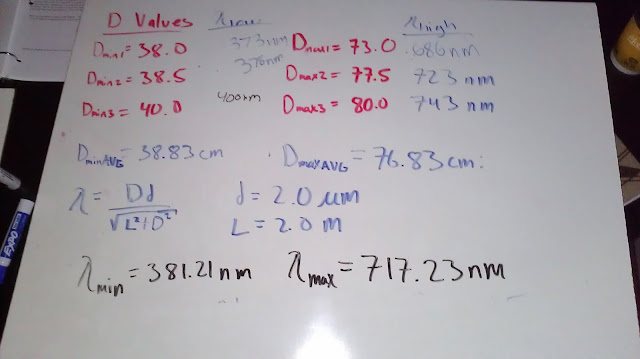Introduction:
Using LED's and a diffraction grating setup, we may formulate a result for Plank's constant. In this experiment, we will measure the wavelength produced by approximately monochromatic light sources by passing their light through a diffraction grating. Similar to the previous experiment, the point of interest, as seen through the diffraction grating will allow us to geometrically solve for the wavelength of the LED. We know this value is correct since wavelengths will constructively interfere at the point of interest. From this, our formula for Planck's constant will be used given the wavelengths of several LEDs. Uncertainty and error calculations will be compared in our measurements.
Steps:
The apparatus from Color and Spectra is used to find LED's wavelength
 |
| Setup with LED powered by a voltage source in series with the LED and resistor seen in the background of this image. |
We will also use the previous equation,
where L is the distance to the LED, d is the diffraction grating spacing, and D is the distance from the LED to the point of interest (constructive interference point).
Once each LED's data is tabulated, we use
 |
| Red LED trial |
 |
| Blue LED trail |
 |
| Green LED trail |
 |
| Yellow LED trail |
 |
| White LED trail (for comparison purposes) |
The data and uncertain calculations are done below.
Where uncertainties are calculated as

Questions/Conclusion:
As we looked through the spectroscope, we noticed only white was a mixture of color out of all the LEDs. This makes sense since it's an incoherent light source with a mixture of wavelengths. The colored LEDs are monochromatic. Therefore, the white LED, as seen through the spectroscope, will produce a band of colors associated with the visible spectrum.
As seen in the table, yellow and green LEDs produced most deviation from uncertainty.
Although the table above shows wavelengths out of order, we observe that voltage increases as we decrease wavelength. This makes sense since higher frequency ( lower wavelength) light has more energy by E=hf.
The slope of our graph yielded 1*10^-6.
The slope
is associated with our measured values of this experiment. This equates to
We notice the right side of the equation is all known constants where
hc/q = 1.24*10^-6
our result therefore has an error
This is a settling result since we took many measurements in our experiment that added towards uncertainty.













